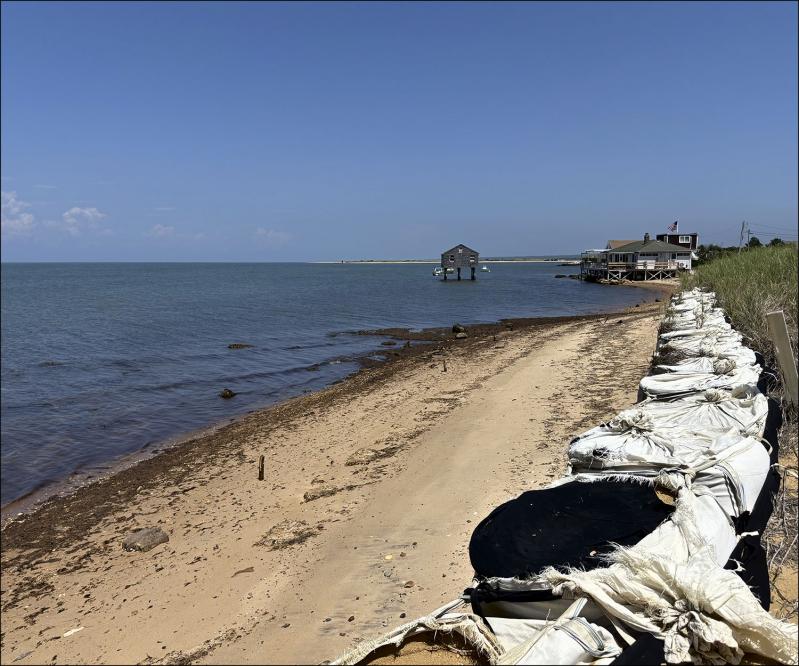A situation that has given rise to multiple lawsuits, angry neighbors, and now potential environmental degradation continues to unfold on Bay View Avenue on Napeague.
Experts disagree on whether Nicholas Grecco’s house at 117 Bay View would become a new feature of Napeague Bay without its wall of geocubes, essentially huge sandbags, strung and piled atop one another, protecting the house from wave attack.
Mr. Grecco, along with his neighbor Stella McCartney, first installed the cubes, which were meant to be temporary, in 2018. Today, they are visible on Google Maps.
Mr. Grecco has an application before the East Hampton Town Zoning Board of Appeals to tear down his current home and build a larger one farther landward. So far, the biggest issue with that plan has been a proposed 108-foot-long, 10-foot-high rock revetment, which would replace the geocubes. Bay View Avenue, however, ends at a section of shoreline where such structures are not permitted by town code.
The revetment was part of the reason the Z.B.A. issued a “positive declaration” on the project, which according to the New York State Environmental Quality Review Act, meant a long, detailed study of the project would be necessary.
Mr. Grecco disagreed, and his attorney, Brian Matthews, sued the town.
The town won. An appeal was filed. That case is ongoing.
With no end in sight, Mr. Grecco submitted a new application to replace his deteriorating [and long illegal] geocubes with fresh ones. Town code allows the massive beanbags, but only as a six-month temporary measure [allowing for a three-month extension] to protect a structure from imminent danger.
The town refused to issue a temporary building permit. Again, Mr. Grecco sued. The town decided to settle that one.
On June 5, Mr. Grecco obtained a new permit from the State Department of Environmental Conservation to reinstall the geocubes in a different configuration.
The new D.E.C. permit calls for 115 linear feet of cubes with a 40-foot linear return. That is a change from the current layout, which has them strewn straight across the beach between the two waterfront residences, blocking the neighbors’ access path and causing consternation.
The new twist is that the homeowner cannot begin replacing the old cubes until the town grants him an emergency building permit. In the settlement, the town agreed to issue the permit, but the code has been changed since the cubes were last installed, to tighten the town’s control over them.
Mr. Grecco is balking at one of the new provisions, which requires homeowners to obtain a “surety bond,” which would provide the town with the necessary funds to remove the geocubes if they overstay their welcome.
At a 2023 public hearing discussing the new legislation, Mr. Grecco spoke against it, calling it “unnecessarily restrictive.”
“The bond is impossible to get,” said Mr. Matthews in a phone call this week. “Nobody is issuing surety bonds for small residential projects. Despite being shown that this is an obstacle, and despite these properties facing emergency situations, the town has done nothing. It’s putting my clients in a difficult position. They want the geocubes gone, too.”
The D.E.C. permit gives Mr. Grecco five years to complete the work. Given the way things have been moving, he may need all the allotted time.
“It took three years and a lawsuit to even get on the zoning board’s agenda,” said Mr. Matthews. “Three years is an inordinate amount of time. We have an application to move the house back and put in a revetment because the house is in immediate danger. We were asking to be heard and getting no response. There was no justification for that.”
The town attorney’s office did not respond to multiple requests for comment this week. Neither was the Town Planning Department interested in commenting, citing the ongoing litigation. A call to the Building Department ended after a 10-minute wait on hold.
A trip to the cubes on Tuesday showed them to be in poor shape, looming over a placid bay. Their tops were exposed and their fabric torn. What was perhaps once a wooden fence, laid atop the cubes in front of Mr. Grecco’s home, was overhanging the wall by two or three feet, the sand below it scoured away. It seemed at risk of falling into the bay.
The cubes act like a retaining wall between a sandy walkway and the shoreline. There is no easy way to descend the six-foot drop to the beach. Nearing low tide on Tuesday afternoon, there were perhaps 15 feet between the cubes and the water.
While the cubes deteriorate and the lawsuits marinate, the outcome remains unclear.
A spotted sandpiper flew east from the shoreline, toward a landmark — a baymark, actually — a deteriorating house that stood at the end of Mulford Lane until the waters rose up and claimed it.




